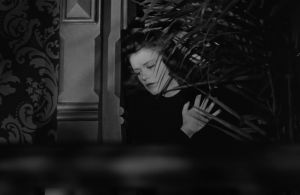Film Deets:
Director: Jacques Tourneur
Screenplay: DeWitt Bodeen
Actresses: Simone Simon, Jane Randolph
Category: Coded Queerness
Themes: Queer Monsters, Otherness
Why do these screams matter?
A coded queer narrative about a woman who resists but ultimately gives in to her primal desires, Cat People explores what Barry Keith Grant called “the dread of difference.” In the film, Irena Dubrovna (Simone Simon) struggles against a part of her identity she fears will render her an outcast. A Serbian immigrant, Irena believes she is descended from a cursed tribe in which any woman who has her passions aroused will shape-shift into a killing panther. Unable to be intimate with Oliver (Kent Smith), a New York architect she impulsively marries, for fear it will activate the curse, Irena is sent to a psychiatrist in search of a cure. The audience is left guessing whether Irena’s paranoia is the result of sexual repression or whether her fears may be well-founded.
Our first scream comes not from Irena but Alice (Jane Randolph). Realizing that Alice is in love with Oliver and worried that Oliver might return those feelings, Irena sets off to follow Alice to the basement pool. Meanwhile, Alice begins to feel as though she is being watched.
While Alice’s screams here are most certainly coming from a very real place of fear, they are also moving the threat posed by Irena from potential to actual. Up until this point, Irena’s concerns that she is cursed have been largely dismissed by both Oliver and Alice. But this scene demonstrates that Irena is, in fact, a shapeshifting monster and that her curse renders her a very real threat to those around her. That this threat is directed toward Alice is intentional. As the “normal” woman in this love triangle, Alice’s relationship with Oliver is one of expressed heteronormativity. And her scream here signals the threat to not only her safety but to traditional domestic relationships.
Alice is a stark contrast to Irena, whose inability to engage in heterosexual sex marks her as an Other in the eyes of the audience. In Hollywood from Vietnam to Reagan, Robin Wood defines “Otherness” as that which returns, despite repression. For Irena to be perceived as a monster, she must be positioned outside of acceptable societal boundaries; the film accomplishes this by coding her as a lesbian and doing so in a way designed to fuel audience terror and unease. In 1942, the United States was still 6 years away from the Kinsey Report estimating 10% of the American population to be gay, 8 years away from the founding of the Mattachine Society, one of the U.S.’s first gay rights groups, and 13 years away from the founding of The Daughters of Bilitis, the United States’ first lesbian political organization. Culturally speaking in 1942, there were simply no mainstream voices that could counter religious-based framing of homosexuality as a perversion.
This thread is continued in the next scream that comes from Dr. Judd (Tom Conway), the psychiatrist who has taken on Irena’s case at the behest of Oliver. As a medical professional, Dr. Judd serves the very specific function of ensuring that the audience reads Irena’s Otherness as a psychological defect. It is a dynamic underscored when, during a therapy session, Irena offers up a sound that I believe can be read as the animalistic equivalent of a scream. In the scene, Dr. Judd attempts to seduce Irena partly because of his sexual interest in her and partly to prove to her that her concerns are all imagined. And let’s just say that things don’t go especially well for Dr. Judd.
The traditional scream heard here comes from Dr. Judd and stems from his awareness that he has severely misjudged the situation and is about to be brutally killed. But there is also a subliminal message being imparted to the audience that Irena’s Otherness, that authentic part of herself society defines as unclean, is not controllable. The only way to eradicate the threat is to destroy the person; something that does come to pass with Irena’s death at the film’s conclusion. But at this moment, Irena has stopped resisting her self-described impure impulses and has embraced her authentic self. The growls we hear her direct toward Dr. Judd are the animal equivalent of a scream and are meant to counter Dr. Judd’s response and to underscore to the audience that ultimately medical intervention cannot tame instinct.
Works Cited
Cat People. Directed by Jacques Tourneur, performances by Simone Simon, Jane Randolph, and Kent Smith, RKO Pictures, 1942.
“Diversity of sexual orientation.” Kinsey Report, 2019, kinseyinstitute.org/research/publications/historical-report-diversity-of-sexual-orientation.php.
Grant, Barry Keith, editor. The Dread of Difference: Gender and the Horror Film. University of Texas Press, 1996.
McHugh, Jess. “‘The Beginning of a Conversation’: What It Was Like to Be an LGBTQ Activist Before Stonewall.” Time Magazine, 25 June 2019, time.com/longform/mattachine-society/.
“The Daughters of Bilitis.” Library of Congress, guides.loc.gov/lgbtq-studies/before-stonewall/daughters-of-bilitis.
Wood, Robin. Hollywood from Vietnam to Reagan . . . and Beyond. Columbia University Press, 2003.





